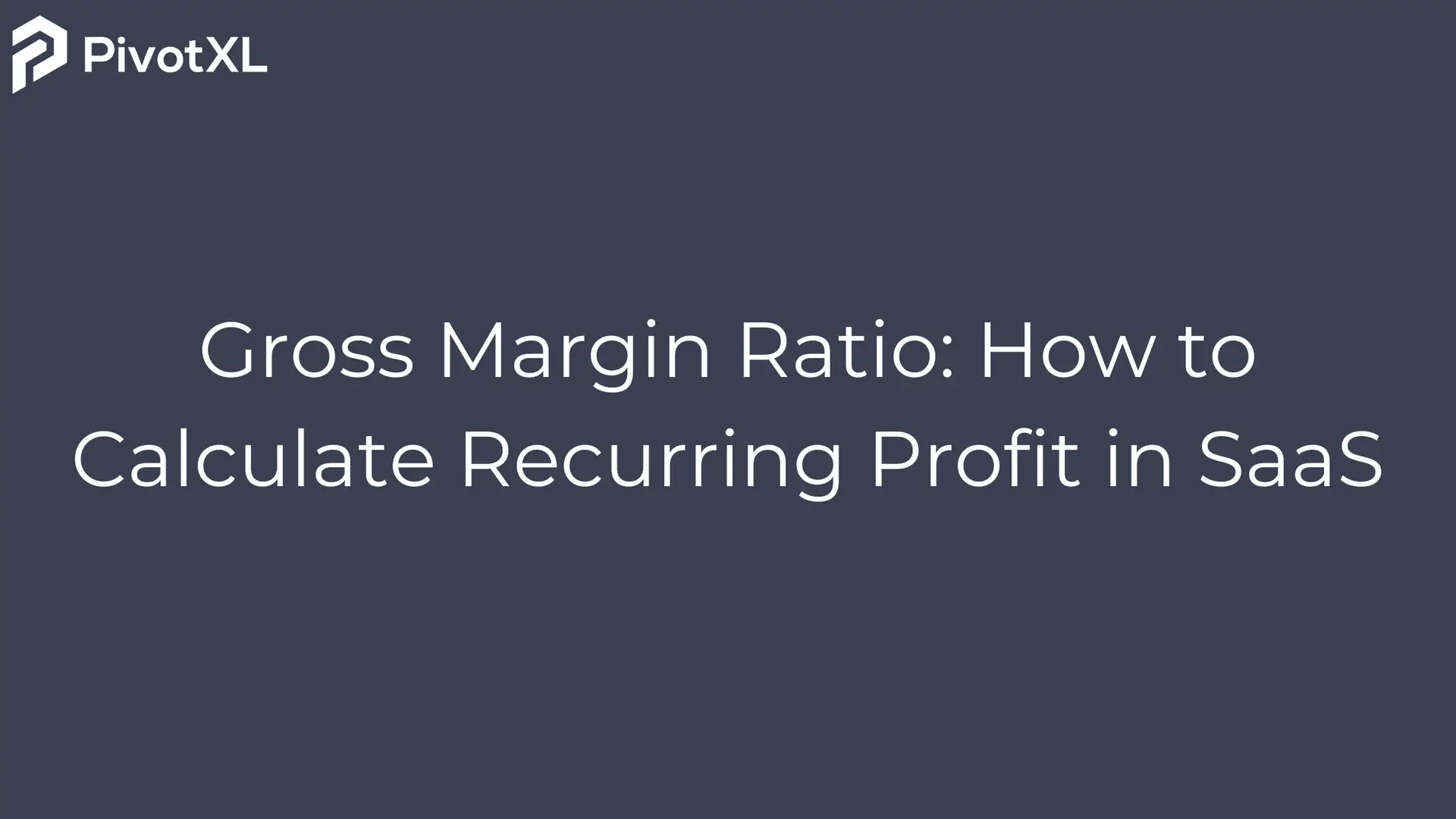Why Is Gross Margin Important in SaaS?
SaaS gross margin tells you what percentage of revenue you will retain as gross profit when you sell a single unit (depending on your pricing strategy) of your product or service. While gross margin is expressed as a percentage, it is far more than just a number—it is an essential indicator of the health and sustainability of your business model.
Revenue isn’t the only measure of a company’s success. The higher the gross margin, the more profitable and sustainable its business model becomes. SaaS companies are characterized by high gross margin ratios in comparison to traditional businesses. The higher gross margin ratios of SaaS businesses are made possible by their typically low cost of delivering services and are what make them extremely attractive to investors.
The gross margin of a SaaS business is composed of two separate components:
- The Subscription Margin: Determined by the recurring revenue generated from product subscriptions.
- The Service Margin: Associated with the one-time revenue generated from offering professional services.
Both aspects of your SaaS gross margin play an important role in painting a valuation picture to investors. The overall gross margin level (which includes both subscription and service margins) indicates whether your business is a true SaaS (typically high gross margin ratios) or a tech-enabled services company (which generally exhibits lower gross margin ratios and a different business model).
With tech-enabled companies, services are a core business offering and integral in fueling the subscription side of the company. However, for true SaaS companies, services are not core to generating or maintaining subscriptions. Therefore, the subscription gross margin is more important in this case, with the services gross margin offering additional context to the overall picture, while remaining important nonetheless.
How to Calculate Gross Margin for SaaS
Here is the standard formula for gross margin:
Standard Gross Margin Formula:
Gross Margin (%) = ((Revenue – COGS) / Revenue) * 100
While this formula works well enough for most industries, it doesn’t provide enough context for a SaaS company. SaaS companies should break this formula down by categorizing their gross margin ratios into services and subscription-based revenue streams.
Calculating Your Subscription Gross Margin
The subscription gross margin is the most important metric for determining profitability for a SaaS business. It’s calculated by subtracting all recurring COGS associated with your SaaS subscriptions from your Annual Recurring Revenue (ARR).
Knowing all the different expenses that should be categorized as COGS for a SaaS company can be a bit challenging compared to companies that sell physical products. For a SaaS company, COGS might include items such as:
- Servers and hosting space: Costs associated with maintaining the software platform.
- Licensing for third-party integrations: Fees to integrate with other tools and services.
- Onboarding expenses: Costs related to onboarding new customers.
- Customer support and account management: Recurring expenses that ensure customer satisfaction.
- Fees and commissions: Payments to various partners involved in the process.
- Employee salaries for core functions: Including those for DevOps, customer support, and customer success.
Note:
- Expenses include salaries, wages, payroll taxes, employee benefits, contract labor, travel costs, training costs, software and tool costs.
- Any expenses that are billed back to the customer should be excluded (for example, travel) under COGS.
- Any implementation costs (or services costs or professional services costs) for the software and tools used by these teams are excluded from COGS.
- Tool costs need to be amortized depending on if they’re paid upfront, in periodic installments, or ad-hoc based on usage.
Subscription Gross Margin (%) = ((ARR – Recurring COGS) / ARR) * 100
Example Calculation:
For a company with an ARR of $1,000,000 and recurring COGS of $250,000, the subscription gross margin would be calculated as follows:
Subscription Gross Margin (%) = ((1,000,000 – 250,000) / 1,000,000) * 100 = 75%
This 75% subscription gross margin is a key indicator of healthy gross margin ratios within the SaaS model.
Calculating Your Services Gross Margin
The services gross margin is calculated by deducting the costs associated with providing one-time services from the additional revenue generated from those services in a given year.
Services Gross Margin (%) = ((Service Revenue – Services COGS) / Service Revenue) * 100
Example Calculation:
Consider a SaaS company that generates $50,000 in total revenue from providing one-time services while spending $40,000 on these services. The services gross margin is:
Services Gross Margin (%) = ((50,000 – 40,000) / 50,000) * 100 = 20%
While the subscription gross margin ratios are often the primary focus for SaaS companies, the services gross margin ratios provide additional context to your overall financial performance.
Accounting for Customer Success
There’s an ongoing debate about how to account for customer success when calculating your SaaS gross margin. According to Ben Murray, the SaaS CFO, the approach depends on the primary focus of your customer success team:
- Retention Focus: If your customer success team is focused solely on retention, then any costs associated with it should be filed under COGS when calculating your subscription margin.
- Referral and Expansion Focus: If a considerable part of your customer success efforts is geared towards generating referrals for new business, those costs should be filed under sales and marketing expenses.
When looking at customer success costs, it is recommended to divide costs based on objective:
- Retention Costs: Include these in COGS.
- Expansion Costs: These should be included as sales and marketing expenses.
This careful allocation is essential to accurately measure your gross margin ratios and provide a true picture of profitability.
What Is a Good Gross Margin for SaaS?
According to the operations team at Software Equity Group, a good gross margin benchmark for SaaS is anything higher than 75 percent. If a SaaS company’s gross margin ratios are lower than 70 percent, that is a red flag for potential investors.
Let’s look at what David Cummings has to say about gross margin:
“Early on, a startup shouldn’t worry too much about gross margin. It’s most important to find product-market fit and build a repeatable customer acquisition process.”
When evaluating the profitability of a mature SaaS business, the gross margin ratios play a vital role that can even trump revenue in importance.
Tomasz Tunguz, Managing Director at Redpoint Ventures, adds:
“Investors prize SaaS companies because providing SaaS service costs very little, and consequently these startups record very high gross margins.”
“The median gross margin for publicly traded SaaS companies expands from 50% in year four to just under 75% in year five… Hosting costs and customer success costs comprise the majority of SaaS Costs of Goods Sold (COGS).”
In summary, while SaaS businesses shouldn’t worry too much about their gross margin ratios early on, most should aim for a gross margin ratio of at least 70% as they mature. A gross margin ratio lower than 70% could signal poor returns and be a concern for investors.
How to Improve Your Gross Margin
Once again, it’s important to recognize that improving your gross margin ratios in a SaaS business is challenging without making radical changes to your core business model. Since these margins are tied directly to the economic fundamentals of your business, any improvements require a deep dive into operational efficiency and cost management. Here are some reiterative points to consider:
- Examine Hosting Costs:
Dive deep into your hosting and cloud usage. Optimize code, remove unnecessary features that consume high resources, and negotiate with providers for better rates. These steps are crucial in raising your gross margin ratios. - Revise Your Implementation Model:
Outsourcing or modifying your implementation strategy can have a direct positive impact on your services gross margin ratios. Consider charging a premium for expedited or specialized services that add value to your customers. - Examine Your Customer Success Motions:
Make sure that the customer success team is operating efficiently. Utilize automation and compare your headcount against industry benchmarks. Optimizing these motions helps control costs and improves your gross margin ratios. - Create Tiered Customer Service:
Introducing tiered support options can enhance profitability. Offering a basic package for free while monetizing premium services is a proven strategy to boost overall gross margin ratios. - Track Profitability Per Customer:
Keep a close eye on the profitability of each customer account. Use detailed metrics to assess where improvements can be made, ensuring that low-margin accounts are either priced appropriately or upsold to higher-margin offerings, thereby lifting your overall gross margin ratios.
Conclusion
SaaS companies should focus on finding product-market fit and building a repeatable customer acquisition process during early development rather than stressing over their gross margin ratios. As the company matures, however, they must target gross margin ratios in the 70–80% range. Companies that achieve these ratios appear more sustainable, profitable, and attractive to investors.
Investors value SaaS companies because they generate revenue at a low cost, which naturally results in high gross margin ratios. Moreover, when a mature business posts a gross margin below 70%, investors see it as a significant red flag. This drop signals potential issues in the cost structure that could hurt profitability and long-term success.
To optimize their gross margin ratios, SaaS companies can analyze both subscription and services components, accurately allocate customer success expenses, and use advanced tools like PivotXL. In addition, they can improve these ratios through better cost management, enhanced pricing strategies, and sophisticated financial modeling. Ultimately, every improvement contributes to a more robust, investor-friendly business model.




